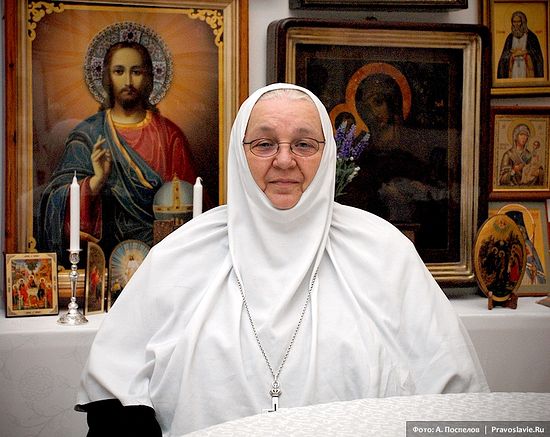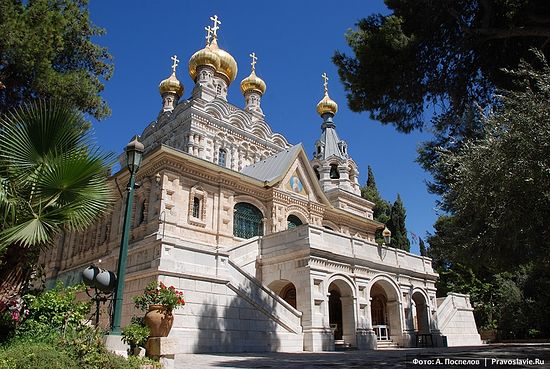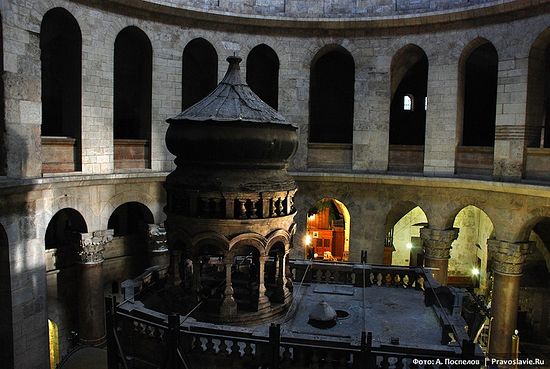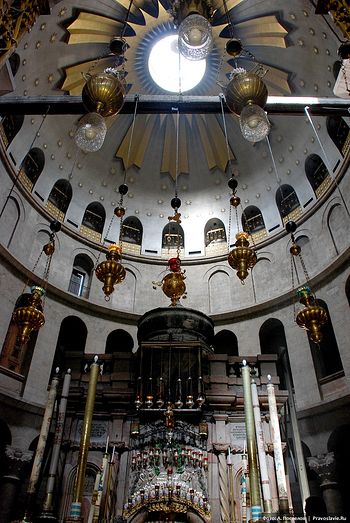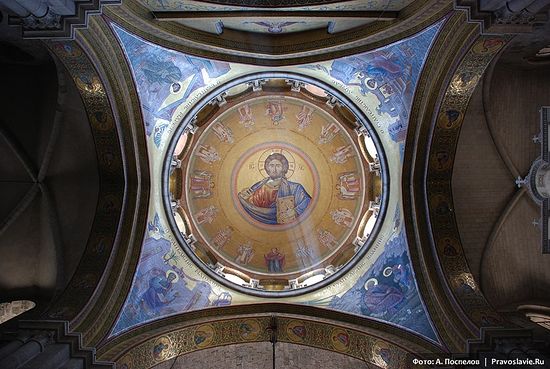Abbess Moisseia’s reminiscences were recorded in the Holy Land, at Holy Ascension Convent on the Mount of Olives, which she has headed for 15 years. Matushka shares her memories of people who led lofty spiritual lives, and how the Lord brought her to the Holy Land.
Vladyka John of Shanghai
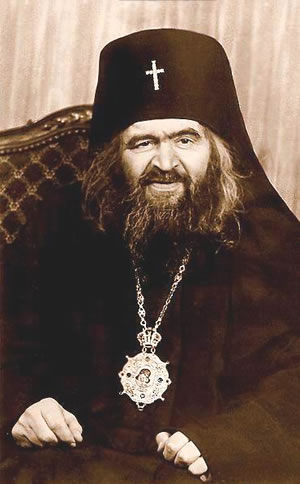 St. John (Maximovitch).
St. John (Maximovitch).
He lived at St Job the Much-Suffering Memorial Church. Fr Modest[1] served there; he was a strict monk, and another priest, Fr Chedomir Ostoich. Fr Chedomir was a Serb by birth; he was forced to flee Serbia, where his family lived—a wife and two daughters. I was about the age of his younger daughter, and he would often stare at me: “Batushka, why are you looking at me like that?” He would reply “Yes, let me look at you—I have a little girl just like you.” He loved children, and we also loved Fr Chedomir a great deal. We liked Vladyka John, too; although he did seem very strict to us. But we understood how much love this person had.
When we would visit Fr Chedomir, he would say: “Call Vladyka to come over for lunch.” We would come up to his door “By the prayers of our Holy Lord Jesus Christ, our God, bless us!” No response, only silence. Again: “By the prayers of our Holy Lord Jesus Christ, our God, bless us!” Again, silence. We say the prayer a third time. Then he responds: “Amen.” Later at Fr Chedomir’s he would say that he didn’t respond because he loved to hear the voices of children praying.
He loved it when children participated in divine services: boys would serve as acolytes, and girls sang and chanted. We were too little to read the Six Psalms yet, and so we read it in turn, dividing it into two parts: one would read it until “Glory to the Father and Son…” and the next would finish “Now and ever…” and would continue the psalms. I remember how Vladyka John would turn around and smile when he saw us children reading. He loved to hear that.
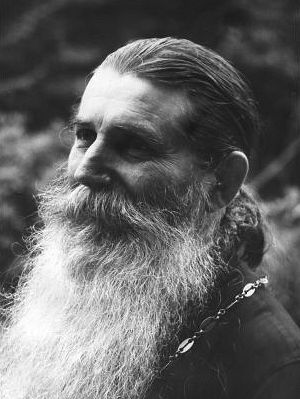 Archpriest Chedomir Ostoich.
Archpriest Chedomir Ostoich.
There were many instances when people would be healed by the prayers of Vladyka John. Here is one of them: Verochka, who sang at our Memorial Church at the time, contracted meningitis. This was after Vladyka John had already been transferred to America in 1962. They sent him a telegram that this girl had meningitis, and the outlook was grave: she faced either death or mental disability. Vladyka responded by telegram that everything would be fine. She soon recovered completely!
But not everyone loved Vladyka John, not everyone respected him. Ladies in big hats, for example. He was disheveled, barefoot, he didn’t tend to his hygiene, and he completely ignored his appearance. But spiritual people understood how powerful his prayers were. They respected and loved him a great deal. One Catholic priest even said once to his parishioners, “Thank the heavens and the saints that one of them walks among us.”
“The Lampada Lit Up By Itself!”
I ended up in the Holy Land almost by accident. But of course nothing happens by accident in this world. In 1974, I wished to travel to Russia, but I was refused a visa. Our batiushka, Fr. Dimitry Khvostoff, was in the process of organizing a pilgrimage to the Holy Land, and his daughter invited me to go, to be Fr. Dimitry’s helper. I agreed. I did not think that I would once again come to the Holy Land and stay for good, that the Holy Land was to be my home. Everything here was so sacred, so remote, so lofty!
I fell in love with the Holy Land from the very first day.
We arrived at night, and the next morning we went to Gethsemane, to the Church of St Mary Magdalene. I didn’t realize what day it was—it turned out to be the eve of the Transfiguration of the Lord, the feast day of St. Nonna. Later, when I was tonsured a riassaphore nun I was given the name Nonna, and I remembered that day: it was a form of prophecy for me.
During that first visit to the convent, we attended Liturgy and vigil, and then traveled to Mount Tabor. Tabor, Galilee… they fell into my soul, making such a great impression on me!
We were all welcomed so warmly. There were very few pilgrims in those days. When we would approach an Orthodox holy site we would be greeted with the ringing of church bells, and bells would bid us farewell, too…
I returned to the Holy Land the following year, on Pascha. Matushka Barbara (Tsvetkova) was in the hospital at the time… She was already old. She was such a fascinating person! She had known Fr. John of Kronstadt as a girl; she would sit on his lap when he would visit their home. She knew [Grand Duchess] Elizaveta Feodorovna and the Royal Family. Her spiritual father was Elder Aristocles who was recently canonized,[2] and he foretold when she was only seventeen that she would be the abbess of such a convent! Her other spiritual guides were Vladyka Arseny (Zhadanovsky), and Vladyka Seraphim (Zvezdinsky). She would talk about them a lot.
So, Mother Barbara was sick then, and her elder cell-attendant was with her. Twenty days earlier, the correspondence secretary had died. Everything was left to the second cell-attendant of the abbess, and now she had to draft letters, too. So she asked me: “Can you write letters in Russian?” “Yes, I can,” I replied. “Help me then,” she asked. And so we began writing letters. When she saw that I could write forty letters to people in one day, she said “Why are you wasting your life in the world? What do you do out there?” “Well,” I said, “I work, I go to church…” Again she asked me “Why are you wasting time there? You are one of us! Come here to live…” And it hit me, “Indeed, what am I doing in the world? I work only so that I can eat and sleep?” On the third day I decided “Why not, after all? I will join the convent. I like it here—I like everything here.” I went to visit Mother Barbara in the hospital, and she rejoiced, saying,“Finally a young Russian girl!” It was mostly Arabs who entered the convent at the time; no one from the Russian emigration would come anymore…
Mother Barbara gave me her blessing, but I wanted another sign that the monastery was for me. I had not ever thought about joining a convent until then, though I had been close to the Church since childhood. I had read and sang on the kliros from the age of nine. Vladyka Anthony of Geneva once told me: “You are a nun, in fact, you will be an abbess…” and we would laugh when he said that. It didn’t sink in to my head or my heart at the time.
And so I decided to go see the Holy Fire. I thought: “I will pray at the Sepulcher of the Lord and wait for a sign from God.” So I went. I didn’t know where to look. I concentrated on the Aedicule. Then all around me, everyone is still, silent. The Patriarch entered it, and suddenly I saw right before my eyes—the flame ignited in the Aedicule! I cried: “Look, look: the lampada lit up by itself!” Then I thought, “This is it! I was given a sign from God! I have His blessing. I will join the convent!”
I joined the convent on December 29, 1975. I vowed right then and there never to leave the convent, only if some heresy or something terrible happens. And that helped me a great deal in my life, because that is the first thing that comes to mind when some temptation arises: “I will leave!” But every time that happened I remembered this vow, and it helped.
Father Nektary
Fr. Nektary (Chernobyl), our spiritual father, had the gift of prayer.
He himself had been a spiritual son of Schema-Igumen Barsanuphius of Kharkov.[3] He was imprisoned because he refused to recognize Metropolitan Sergius (Stragorodsky). He was punished by being forced to stand for ten days in a row. Twice he was even led out to be shot, and each time the Lord had mercy on him. He was forced to work on building the Belomorkanal (White Sea Canal); he served three sentences in the concentration camps. During the war he made his way to Germany, then to Switzerland, where he joined the Russian Church Abroad. He was sent to America, to the monastery in Jordanville. Since there was a need for priests and father confessors in the Holy Land, he was then sent here. He was a righteous monk, exemplary, and he maintained a quiet life.
Fr. Nektary prayed without ceasing. He never missed a single divine service. And he was constantly at work. He was long past seventy by this time. He maintained a vegetable garden in the Mount of Olives convent. He made wooden crosses in the workshop. He would always rise after midnight read his prayer rule, prepare for Liturgy, and go to church (he served at the convent of St. Mary Magdalene and he had a cell there, as well as here on the Mount of Olives. He would spend the night there, and rest here during the day. When he became much older he stayed at the Mount of Olives). When I lived in St Mary Magdalene Convent, my room was right across from his cell, and I would see the light burning in his room at night. After church Fr. Nektary would eat just a little bit and then walk up to the Mount of Olives Convent. Upon his return he would immediately begin work in the garden or the workshop. He would fix everything in the convent; his hands were like gold—he was a watchmaker by profession. And so he worked until evening. When he heard the bells of St. Mary Magdalene—which, by the way, you can hear on the Mount of Olives—he would quickly wash his face and run down to Gethsemane, reading the Ninth Hour by heart, and arriving just in time to begin Vespers. That was his daily schedule.
Nothing ever hindered him from prayer. Now a great many pilgrims come to the Holy Land, and there is jostling and shouting at the Lord’s Sepulcher. I have heard many people say that this prevents them from concentrating on prayer. We are weak, but nothing bothered Fr. Nektary. We have an entirely different attitude towards the sacred. We must learn to concentrate on our prayers. If we could learn this, we could rise above all the fuss and bother surrounding us.
